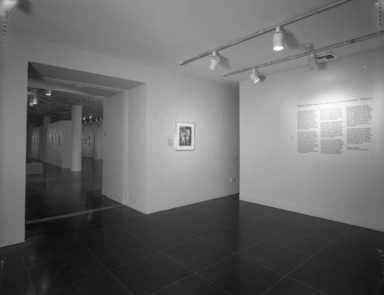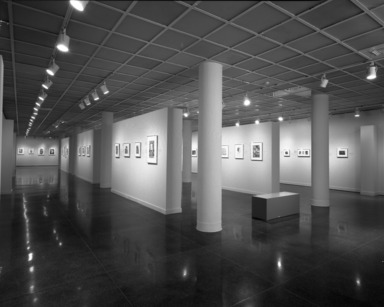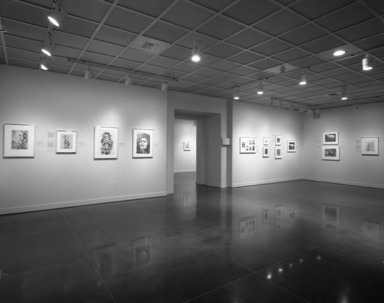

Mexican Prints from the Collection of Reba and David Williams, April 03, 1998 through August 10, 1998 (Image: PHO_E1998i007.jpg Brooklyn Museum photograph, 1998)
Mexican Prints from the Collection of Reba and David Williams
DATES April 03, 1998 through August 10, 1998
ORGANIZING DEPARTMENT
Arts of the Americas
COLLECTIONS
Arts of the Americas
-
February 1, 1998
Mexican Prints from the Collection of Reba and Dave Williams will open in the Blum Gallery at the Brooklyn Museum of Art on April 2 and remain on view until August 10, 1998. Over one hundred twenty-five pieces will be on view in the exhibition, which will include works by Elizabeth Catlett, Jean Charlot, Frida Kahlo, Leopoldo Méndez, Pablo O’Higgins, José Clemente Orozco, Diego Maria Rivera, David Alfaro Siqueiros, and Rufino Tamayo.
The exhibition, with works by forty artists, surveys the complete range of printmaking in Mexico from the 1920s to the 1950s, revealing the Mexican artists’ characteristic synthesis of indigenous and European influences, including surrealism and cubism. Various printmaking techniques will be represented, including etching, lithography, woodcut, and linocut. The exhibition will also include prints by non-Mexican artists who worked in Mexico, as well as prints by Mexican artists that were made outside of Mexico.
Beginning in the 1920s, Mexico witnessed an important graphics revival that paralleled the more widely known mural movement in the country. Like murals, prints were a popular medium well suited to political commentary. This less-expensive method for producing artworks on paper appealed to several artists, including the three leading Mexican muralists, José Clemente Orzoco, Diego Maria Rivera, and David Alfaro Siqueiros, who had inspired a massive public following through the use of public sites. Many of their works depicted themes common to Mexican artists of the time: the Mexican Revolution and portraits of its heroes, a concern for the condition of the Mexican everyman at work—laborers, farmers, and miners—and images that revealed the milieu within which they lived—the colorful markets, religious images, mothers, and children.
The first prints of the Mexican modern era to be seen outside Mexico were woodcuts made in New York by Rufino Tamayo (1899–1991), who visited America in the late 1920s. They were shown in an exhibition at the Weyhe Gallery in New York, which would soon exhibit Orozco’s first prints made in New York, as well as those of Rivera. Rivera’s work included a rare nude depiction of his wife, Frida Kahlo.
In 1937, the Taller de Gráfica Popular (TGP) was founded in Mexico by Leopoldo Méndez, Luís Arenal, and Pablo O’Higgins, all of whom had painted murals. Many of the prints in this exhibition were created in this cooperative print workshop, which was established to publish prints on revolutionary topics to educate the public. As the Weyhe Gallery drew Mexican artists to New York, so, too the TGP drew American artists to Taxco, Mexico, including the American O’Higgins, a founding artist, and Elizabeth Catlett, whose work is on view in this exhibition.
Mexican Prints from the Collection of Reba and Dave Williams is circulated by The American Federation of Arts (AFA) and travels to Brooklyn after stops at the Fitzwilliam Museum in Cambridge, England; Calcográfic Nacional in Madrid; Vienna Academy of Fine Arts in Vienna; and the Hunterian Museum in Glasgow.
Reba and Dave Williams have built one of the finest private print collections in this country. Alone in a Crowd, Prints of the 1930s and 1940s by African-American Artists, which was presented to critical and popular acclaim at the Brooklyn Museum of Art in 1996, was also taken entirely from their collection.
Brooklyn Museum Archives. Records of the Department of Public Information. Press releases, 1995 - 2003. 01-06/1998, 026-28.
View Original -
May 1, 1998
A wide range of public programs will be presented in connection with the exhibition Mexican Prints from the Collection of Reba and Dave Williams on view at the Brooklyn Museum of Art from April 2 through August 10. They include a symposium that will explore recent scholarship in the field, a series of classic Mexican films, group tours, and storytelling.
Schedule of Events:
Saturdays, 6–9 p.m.
April 25, June 6, June 13
Ambient Music
April 25
Featuring Mariachi Tequila
Together for ten years, the band, led by Leo Cruz on guitar and vocals, has performed in venues including the Taj Mahal in Atlantic City and resorts in the Pocanos. Bandleader Cruz is featured in a film to be released in May, Used Parts, and the band appeared in Woody Allen’s film Scenes from a Mall.
June 6
Featuring Tomas Rodriguez
Brooklyn born, this classically-trained guitarist continued his studies after Bard College in Spain, where he learned flamenco guitar. Upon his return, he attended the Manhattan School of Music on scholarship. The dazzling confluence of Flamenco, Brazilian choro, samba and bossa nova, Puerto Rican danza, American folk, country, and rhythm-and-blues fills his original compositions. His CD, Guitarra de mi Alma, features a collection of guitar works and original compositions.
June 13
Featuring Clave Norteña
These four musicians, on accordion, guitar, bass and drums, and vocals, perform a type of music from Mexico called norteña.
Ambient Music programs are free with Museum admission.
Friday, May 30
10 a.m.–3 p.m.
Symposium: A New Look at the History of Mexican Printmaking
Moderated by Marilyn Kushner
Curator of Prints, Drawings,
and Photographs
Three scholars report on recent scholarship in the field:
James Wechsler
Curatorial Research Consultant, Reba and Dave Williams Collection
Ph.D Candidate, Department of Art History, The Graduate Center of the City University of NY
Dr. Thomas Gretten
Department of the History of Art[,] University College, London
Dr. Renato Gonzales Mello
Instituto de Investigaciones Estéticas Universidad Autonoma de Mexico, Mexico City
For information and registration, call (718) 638-5000, ext. 230.
Saturdays, June 13–August 29
6 p.m.
The Cinematography of Gabriel Figueroa
The series features films in Spanish with English subtitles, with the exception of The Fugitive and Two Mules for Sister Sara.
Saturday, June 13
Out There on the Big Ranch/Allá en el Rancho Grande (1936)
Director: Fernando de Fuentes
This film inaugurated the ranchera, a distinctly Mexican genre that reflects the values and customs of a ranching economy in an idealized depiction of old hacienda life. The film depicts three life-long friends who maintain their bond despite class barriers.
Saturday, June 20
Maria Candelaría (1947)
Director: Emilio Fernandez
Winner of the 1947 Palm d’Or at the Cannes Film Festival, this fictional story about a Mexican Indian flower vendor, Maria Candelaría, who is scorned by her community after she poses for a portrait to which the artist attaches a nude figure that is mistaken for hers, races toward a tragic end.
Saturday, June 27
The Pearl/La Perla (1945, 106 min.)
Director: Emilio Fernandez
Based on a novella by John Steinbeck, the film version was an entirely Mexican production. The story recounts the Mexican legend of a desperately poor Indian couple who find a magnificent pearl. As the tale unfolds, it becomes clear that instead of transforming their lives as they had hoped, they find themselves victims of the greed and murderous actions of others.
Saturday, July 11
The Young and the Damned/Los Olividados (1950)
Director: Luis Buñuel
A classic tale of poverty, delinquency, and crime in a poor town outside of Mexico City. Buñuel uses the postwar Neo-realist style that transforms and expands the story into a larger exploration of human fears and desires.
Saturday, July 18
Nazarin (1958, 94 mm.)
Director: Luis Buñuel
Set in the pre-revolutionary Porfirio Diaz era, this film evokes both the Passion Play and Don Quixote, as the defrocked priest Nazarin discovers his own humanity as he experiences the unconditional charity of others.
Saturday, July 25
The Fugitive (1947)
Director: John Ford
Based on the Graham Greene book The Power and the Glory. Henry Fonda plays a priest in an unnamed Latin American country where religion is outlawed. He performs a secret baptism on an illegitimate child, flees, and then returns to town to face the consequences.
Saturday, August 1
Two Mules for Sister Sara (1970)
Director: Don Siegel
Shirley M[acL]aine stars with Clint Eastwo[o]d in this Hollywood comedy about mistaken identity and misplaced chivalry.
Repeated Screenings:
Saturday, August 8
Out There on the Big Ranch
Saturday, August 15
Maria Candelaría
Saturday, August 22
The Pearl
Saturday, August 29
Nazarin
Film tickets are $6 for adults and $4 for BMA Members, students, and older adults. For more information call (718) 638-5000, ext. 230.
Saturdays, 4 p.m.
June 27, July 25, August 1
Story Corner
June 27
With Robert Forloney and Jennifer Oxman
This lively storytelling team relates tales inspired by the images of work and play depicted in Mexican Prints from the Collection of Reba and Dave Williams.
July 25
With Susan McCullough
Susan McCullough frees the imagination with tales from Mexico that focus on the magical transformations of people and animals.
August 1
Felix Pitre celebrates the legends and culture of Mexico with captivating songs, music, and language. His repertoire includes songs like Coyote Rings the Wrong Bell, from Mexico, and his stories come alive with the help of a puppet frog named Coqui in this bilingual, interactive program. Pitre is also the author of two bilingual books, Juan Bobo and the Pig and Paco and the Witch.
Blum Gallery, 1st Floor
Saturdays, June 13 and June 27
Spotlight Tours
with Jenny Bilenker, Educator
Saturday, June 13, 5 p.m.
Saturday, June 27, 5 p.m.
Jenny Bilenker will lead two Spotlight Tours which will explore the relationship between works in the Mexican Prints from the Collection of Reba and Dave Williams and objects in the Museum’s Mesoamerican collection.
Brooklyn Museum Archives. Records of the Department of Public Information. Press releases, 1995 - 2003. 01-06/1998, 120-124.
View Original -
May 1, 1998
In conjunction with Mexican Prints from the Collection of Reba and Dave Williams, the Brooklyn Museum of Art presents a weekend evening film series, The Cinematography of Gabriel Figueroa, that will begin at 6 p.m. on Saturday, June 13, and end on Saturday, August 29.
Curated by film historian, critic, and artist Coco Fusco, the series celebrates the masterful work of cinematographer Gabriel Figueroa. Born in Mexico City in 1908 and orphaned at age seven, he learned photography as a trade and later became well-known for his photographs of Mexican revolutionaries. Figueroa learned cinematography in the United States from Gregg Toland, Orson Welles’ cinematographer. When he returned to Mexico in the late 1930s he formed a filmmaking team with director Emilio Fernandez. The cinematic style he created over thirty years has been likened to Mexican mural painting; Figueroa attributed this to the influence of the artists Diego Rivera and José Clemente Orozco on his sense of lighting and perspective. The distinctive images he translated to film portray a Mexico populated by cowboy heroes and romantic lovers, images of the country that endure in the popular imagination.
Figueroa was active in progressive politics in Mexico and befriended several Hollywood actors and filmmakers who fled the United States during the McCarthy era. As a result, he was blacklisted in Hollywood and could not accept a contract offered in 1948 by American director John Ford after the success of The Fugitive.
Nonetheless, Figueroa continued an active production schedule in Mexico, creating an oeuvre that celebrates the life, light, and spirit of Mexican culture. The series also highlights the work of Mexican director Emilio Fernandez and the Spanish avant-garde filmmaker and writer Luis Buñuel.
All films are shown in the Iris and B. Gerald Cantor Auditorium on the Museum’s third floor.
Saturdays, June 13–August 29
6 p.m.
The Cinematography of Gabriel Figueroa
The series features films in Spanish with English subtitles, with the exception of The Fugitive and Two Mules for Sister Sara.
Saturday, June 13
Out There on the Big Ranch/Allá en el Rancho Grande (1936)
Director: Fernando de Fuentes
This film inaugurated the ranchera, a distinctly Mexican genre that reflects the values and customs of a ranching economy in an idealized depiction of old hacienda life. The film depicts three life-long friends who maintain their bond despite class barriers.
Saturday, June 20
Maria Candelaría (1947)
Director: Emilio Fernandez
Winner of the 1947 Palm d’Or at the Cannes Film Festival, this fictional story about a Mexican Indian flower vendor, Maria Candelaría, who is scorned by her community after she poses for a portrait to which the artist attaches a nude figure that is mistaken for hers, races toward a tragic end.
Saturday, June 27
The Pearl/La Perla (1945, 106 min.)
Director: Emilio Fernandez
Based on a novella by John Steinbeck, the film version was an entirely Mexican production. The story recounts the Mexican legend of a desperately poor Indian couple who find a magnificent pearl. As the tale unfolds, it becomes clear that instead of transforming their lives as they had hoped, they find themselves victims of the greed and murderous actions of others.
Saturday, July 11
The Young and the Damned/Los Olividados (1950)
Director: Luis Buñuel
A classic tale of poverty, delinquency, and crime in a poor town outside of Mexico City. Buñuel uses the postwar Neo-realist style that transforms and expands the story into a larger exploration of human fears and desires.
Saturday, July 18
Nazarin (1958, 94 min.)
Director: Luis Buñuel
Set in the pre-revolutionary Porfirio Diaz era, this film evokes both the Passion Play and Don Quixote, as the defrocked priest Nazarin discovers his own humanity as he experiences the unconditional charity of others.
Saturday, July 25
The Fugitive (1947)
Director: John Ford
Based on the Graham Greene book The Power and the Glory. Henry Fonda plays a priest in an unnamed Latin American country where religion is outlawed. He performs a secret baptism on an illegitimate child, flees, and then returns to town to face the consequences.
Saturday, August 1
Two Mules for Sister Sara (1970)
Director: Don Siegel
Shirley M[acL]aine stars with Clint Eastwo[o]d in this Hollywood comedy about mistaken identity and misplaced chivalry.
Repeated Screenings:
Saturday, August 8
Out There on the Big Ranch
Saturday, August 15
Maria Candelaría
Saturday, August 22
The Pearl
Saturday, August 29
Nazarin
Film tickets are $6 for adults and $4 for BMA Members, students, and older adults. For more information call (718) 638-5000, ext. 230.
Brooklyn Museum Archives. Records of the Department of Public Information. Press releases, 1995 - 2003. 01-06/1998, 125-128.
View Original

